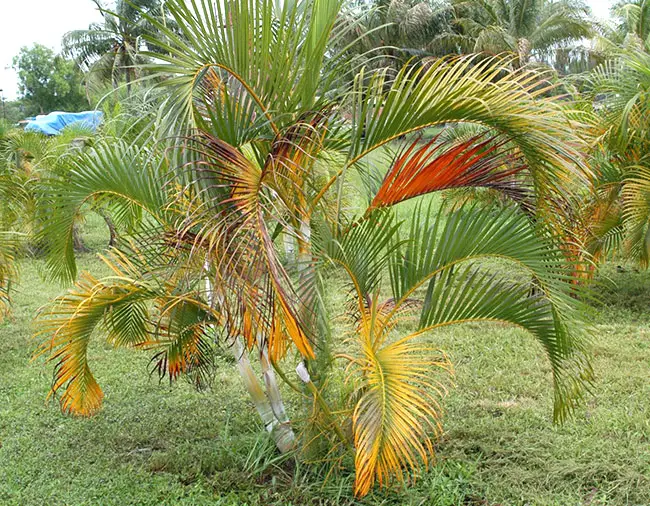

Preventing nutritional deficiencies in palm trees is easily achieved through an annual fertilization program. The correct balance of essential elements, such as nitrogen, phosphate, and potassium, is very important for a palm’s well-being.
Deficiencies in one or more of these nutrients can lead to various health issues and compromise the tree’s overall aesthetic appeal.
As a general guideline, it’s recommended to fertilize palm trees 2-3 times a year, specifically during the growing season, using a fertilizer specially designed for palm trees. The best method for applying the fertilizer is to distribute it evenly across the entire root zone of the plant while avoiding direct application near the trunk.
The timing of your fertilization schedule may vary depending on the product you use, but the most suitable period to fertilize palm trees falls within the growth season, which typically spans from the end of March to the end of October. However, in warm climates where temperatures remain above freezing, you may need to apply fertilizer up to four times a year.
In regions where temperatures occasionally dip below freezing, it’s crucial to cease fertilization a few months prior to the onset of the first cold snap.
Interestingly, some palm enthusiasts advocate for winter fertilization, believing it aids in maintaining the plant’s strength and readiness for the upcoming spring growth season. However, I hold a different view. I believe this practice encourages growth at an inappropriate time, weakening the tree before the onset of cold weather.
Also, if you’ve recently planted a palm tree, refrain from fertilizing it until after it produces a new spear, typically around two months after planting. Mature palms, on the other hand, should adhere to their standard fertilization schedule.
Fertilizing palm trees doesn’t differ significantly from fertilizing other types of plants. To ensure optimal results, it’s essential to choose the right-quality fertilizer, adhere to a proper schedule, and apply the correct amount to avoid over-fertilization.
Consider investing a bit more in a continuous-release formula, as it’s less labor-intensive and offers greater benefits to your plants.
In this example, we’ll use Miracle-Gro Palm Tree Food, which features a slow-release formula specially crafted for palm trees. It boasts an NPK ratio of 8-4-8 and includes additional micronutrients.
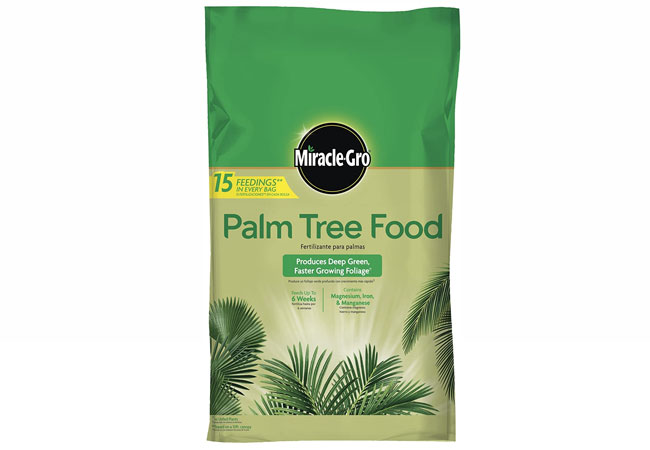
Avoid fertilizing dry soil by thoroughly watering the area first.
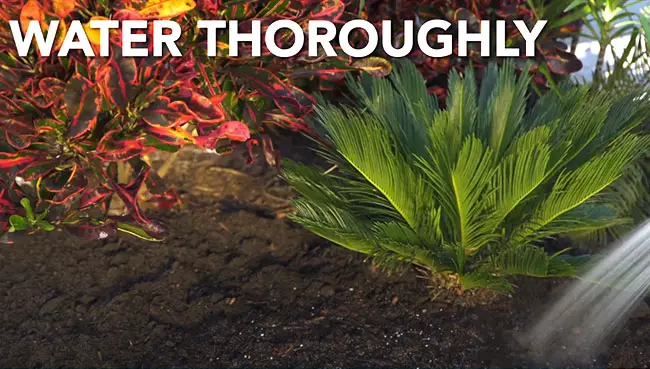
Avoid dumping all the fertilizer in one spot. Instead, scatter it evenly around the root area of the tree, which generally extends to the edge of the canopy. If there is mulch, gently move it aside before applying the fertilizer.
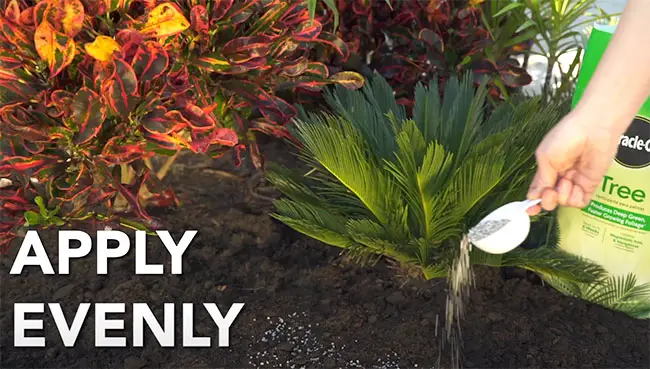
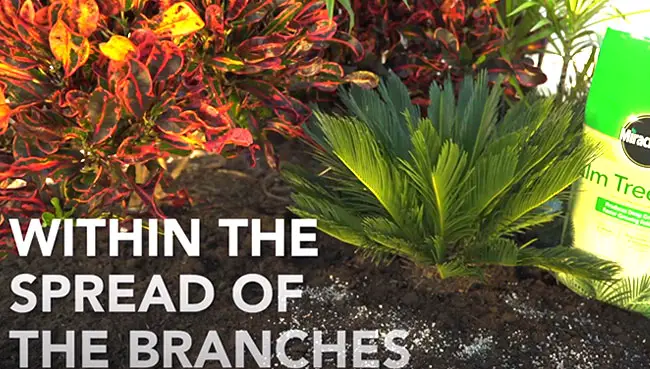
If the soil isn’t excessively compacted, gently work the fertilizer into the top 1-3 inches of soil. This aids in its absorption.
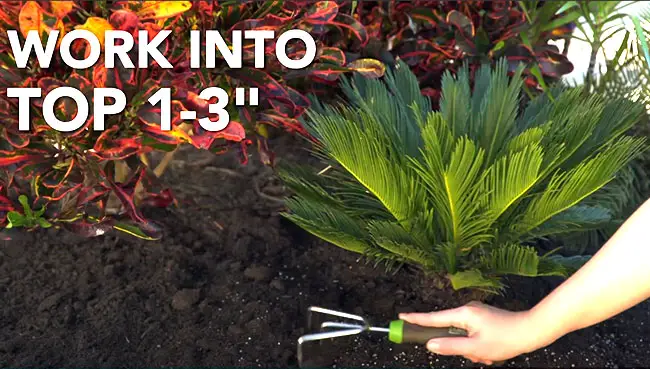
Conclude the process by giving the soil another thorough watering. Miracle-Gro Palm Tree Food, for instance, provides nourishment for up to 6 weeks.
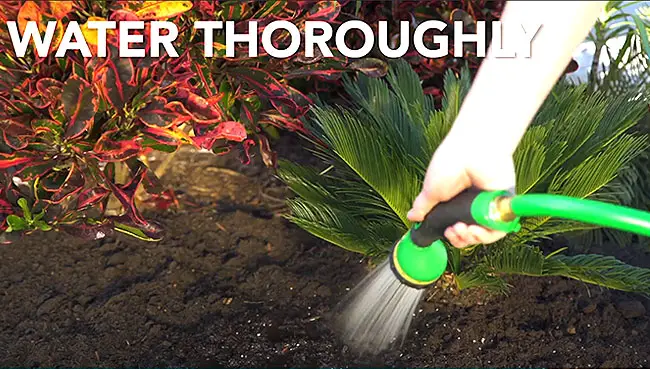
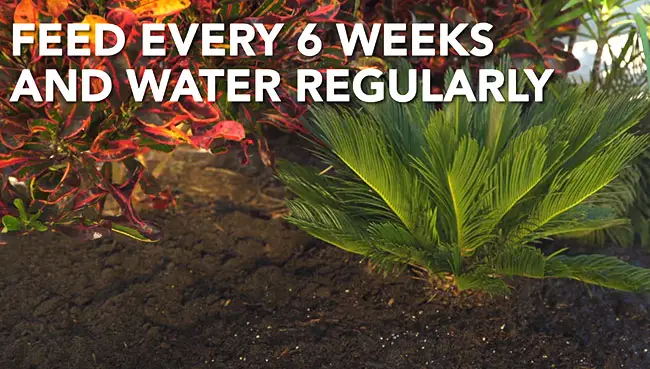
Here is a great step-by-step video that you can follow.
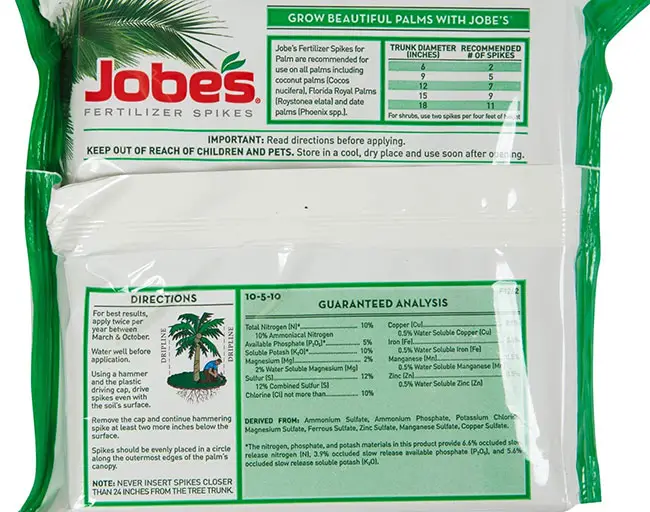
Another one with NPK of 12-4-12 and the micronutrients.
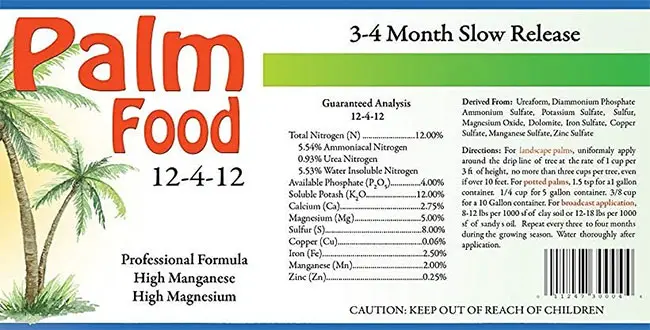
Ensuring your palm tree gets a high-quality fertilizer or plant food “supplements” is crucial for maintaining its overall health.
As I’ve mentioned earlier, it’s far better to opt for a fertilizer with a continuous release formula that nourishes your palm tree for several months, rather than settling for a cheap alternative that gets washed away after just a couple of rains.
While the market offers numerous products, let me introduce you to my top five favorite fertilizers, all of which feature a slow-release formula and the ideal NPK ratio for your palm’s well-being.
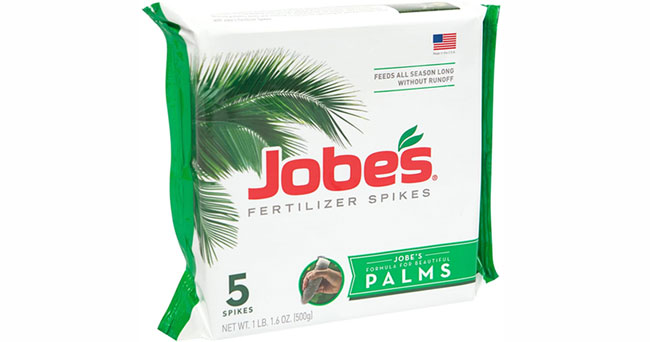
If you’re in search of an easy-to-use fertilizer boasting a slow-release formula, look no further than Jobe’s Palm Fertilizer. This product not only fosters root development but also supports the long-term vitality of various palm tree types.
Designed with a slow-release formula featuring an NPK ratio of 10-5-10, it effectively provides essential nutrients to your palms, guarding against common deficiencies in Manganese, Magnesium, Potassium, and Iron.
When positioned underground close to your palm’s feeder roots, these spikes gradually release nutrients precisely where the tree needs them most.
Special binders ensure that the fertilizer dissolves at a slow and safe pace, nourishing your tree for up to 6 months. You can find Jobe’s Outdoor Palm Fertilizer and Jobe’s Indoor Palm Fertilizer available for your convenience.
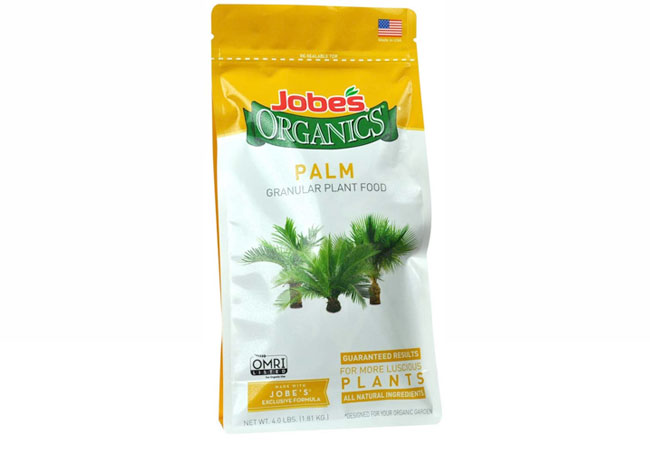
With over 4,000 five-star reviews on Amazon, it’s safe to say that Jobe’s Organics ranks as one of the BEST fertilizers on today’s market. Made by the same company, it delivers long-term benefits without synthetic chemicals or toxic ingredients.
What’s in it? It contains Biozome, which is a combination of healthy bacteria, Mycorrhizal fungi, and Archaea.
This unique and proprietary blend of beneficial microorganisms, with an NPK ratio of 4-2-4, improves soil quality, increases root mass, promotes plant growth, and helps your garden resist diseases, insects, drought, and other unfavorable conditions throughout the growing season.
More importantly, it is safe for use around kids and pets. Since it comes in granular form, you will need to measure it before application. It lasts up to 3 months.

If you’re seeking an easy-to-apply fertilizer, Miracle-Gro is a great choice. Formulated specifically for palm trees, it features a slow-release formula with an NPK ratio of 8-4-8.
Added magnesium, iron, and manganese help prevent fronds from yellowing and curling, while the slow-release nitrogen prevents overfeeding and burning.
This is one of the best palm tree fertilizers available today. It provides a fast, efficient, and long-lasting method for fertilizing palm trees and contains all the nutrients your palm trees need. Each bag contains 15 feedings (based on a 10 ft tree), and it lasts up to 6 weeks.
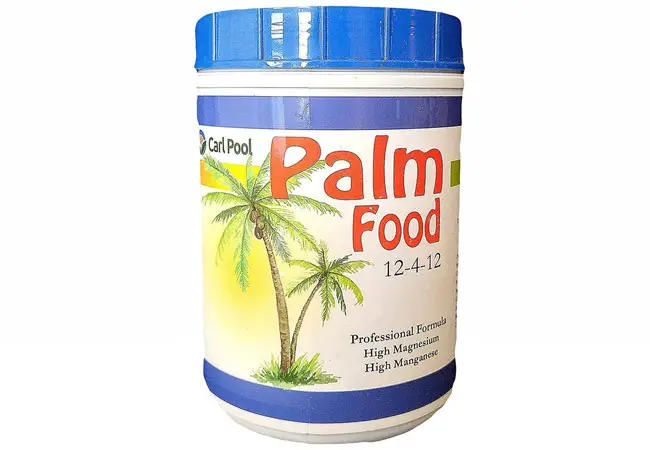
Another excellent option is Palm Food by Carl Pool. While it may not be an organic formula, it boasts elevated levels of magnesium and manganese.
Moreover, it incorporates three different nitrogen sources, providing your palms with both immediate and extended feeding. Utilizing insoluble nitrogen, it resists leaching and ensures groundwater remains uncontaminated.
This highly effective fertilizer, favored by many professionals, features a slow-release formula with an NPK ratio of 12-4-12, complemented by 5% magnesium and 2% manganese. It remains effective for 3-4 months.
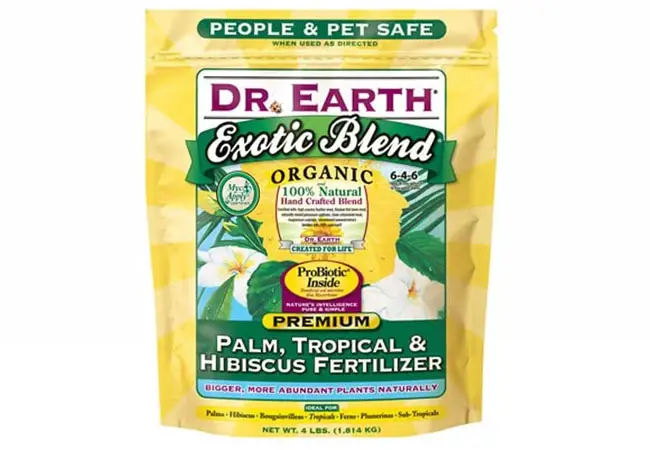
Last but certainly not least, the Organic Dr. Earth Exotic Blend stands as the sole Non-GMO Project Verified fertilizer in the US. It caters not only to palms but also to other tropical and sub-tropical plants. Its organic formula excludes synthetic chemicals and harmful ingredients, making it safe for people and pets alike.
Enriched with feed-grade ingredients, proteins, multi-minerals, carbohydrates, humic acids, and trace elements, it cultivates healthy soil, fostering robust and vibrant palms.
This organic fertilizer proves ideal, especially if you have other tropical plants growing alongside your palm tree. You won’t need to purchase two different fertilizers. Its NPK ratio is 5-4-6, and it contains 2% magnesium, offering effectiveness for up to 2 months.
While this topic deserves its dedicated post, let’s briefly discuss nutrient deficiencies before delving into the best fertilizers.
If you’re just getting started with gardening, this might seem a bit puzzling because many of these deficiencies show up as yellowing, making it tricky to distinguish between them. So, if you think your palm might be dealing with a deficiency, my advice is to go ahead and apply a good-quality fertilizer.
For more info on nutrient deficiencies in palms, check out the University of Florida’s website. They’ve got some great examples of deficiencies in various palm species.
Epsom salt is a mineral compound composed of magnesium and sulfur. It can indeed serve as a valuable fertilizer for palm trees suffering from magnesium deficiency.
However, it’s important to note that Epsom salt, while beneficial, cannot entirely replace a comprehensive palm fertilizer. Palms require other essential elements such as nitrogen, phosphorus, and potassium for optimal growth.
For a 10-foot tall palm tree, you can apply approximately 2 pounds of Epsom salt. Here’s how to do it: first, evenly distribute the salt around the root area of the palm tree, being cautious not to place it too close to the trunk.
Then, thoroughly water the area to ensure the salt dissolves and reaches the roots. Repeat this process three times during the growing season for best results.
Fertilizing a multitude of trees each year can be quite costly. To save money, many property owners are experimenting with homemade fertilizer solutions.
However, not all homemade fertilizer recipes are effective. One such recipe I encountered online involves the following ingredients:
The instructions suggest mixing these components and using 1 ounce of the mixture per 1 gallon of water. Sadly, this is a scam. It’s not going to work.
Firstly, the concentration of magnesium in this mixture is much higher than that of nitrogen. Additionally, it lacks essential nutrients like potassium and phosphorus, except for a minimal amount found in the beer.
Furthermore, since this homemade fertilizer is in liquid form, it will be easily washed away by the first rainfall. Consequently, the plant’s roots won’t have sufficient time to absorb the nutrients, rendering the fertilizer ineffective.
Ultimately, this approach results in a waste of both your money and time, offering no real benefits to your palm trees.